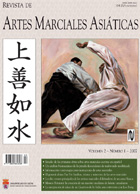Información y estrategias para instructores de artes marciales que trabajan con niños diagnosticados con trastornos por déficit de atención/hiperactividad
DOI:
https://doi.org/10.18002/rama.v2i1.283Resumo
Não há resumo disponível em Português
Downloads
Métricas alternativas
Referências
American Psychiatric Association. (2000). Diagnostic and statistical manual of mental disorders Washington, DC: American Psychiatric Association.
Ashley, S. (2005). The ADD & ADHD answer book. Naperville, IL: Sourcebooks.
Barkley, R. A. (1996). Attention-defi cit hyperactivity disorder. En E. J. Mash & R. A. Barkley (Eds.), Child psychopathology (pp. 63-112). New York, NY: Guilford Press.
Cooper, E. K. (2005a). The effects of martial arts on inattention, impulsivity, hyperactivity, and aggression in children with attention-deficit/hyperactivity disorder: A single-subject multiple-baseline design across participants. Unpublished doctoral dissertation, Capella University, Minnesota.
Cooper, E. K. (2005b). Using observational learning methods for martial arts teaching and Training. Journal of Asian Martial Arts, 14(3), 8-21.
Corcoran, J., & Graden, J. (2001). The ultimate martial arts Q&A book. Chicago, IL: Contemporary Books.
Etscheidt, M. A., & Ayllon, T. (1987). Contingent exercise to decrease hyperactivity. Journal of Child and Adolescent Psychotherapy, 4, 192-198.
Felmet, M. B. (1998). The effects of karate training on the levels of attention and impulsivity of children with attention deficit/hyperactivity disorder. Unpublished doctoral dissertation, The University of Toledo, Ohio.
Hersen, M., & Barlow, D. H. (1976). Single-case experimental designs: Strategies for studying behavior change. New York, NY: Pergamon Press.
Joughin, C., Ramchandant, P., & Zwi, M. (2003). Attention-defi cit/ hyperactivity disorder. American Family Physician, 67, 1969-1970.
Kim, S. H. (1999). Teaching diffi cult children. Wethersfi eld, CT: Turtle Press.
Klein, S. A., & Deffenbacher, J. L. (1977). Relaxation and exercise for hyperactive impulsive children. Perceptual and Motor Skills, 45, 1159-1162.
Lawler, J. (2003). Martial arts for dummies. New York, NY: Wiley Publishing.
Maayan, R., Yoran-Hegesh, R., Strous, R., Nechmad, A., Averbuch, E., Weizman, A., & Spivak, B. (2003). Three-month treatment course of methylphenidate increases plasma levels of dehydroepiandrosterone (DHEA) and dehydroepiandrosterone-sulfate (DHEA-S) in attention deficit hyperactivity disorder. Neuropsychobiology, 48, 111-115.
Morand, M. K. (2004). The effects of mixed martial arts and exercise on behavior of boys with attention deficit hyperactivity disorder. Unpublished doctoral dissertation, Hofstra University, New York.
Pary, R., Lewis, S., Matuschka, P. R., & Lippmann, S. (2002). Attentiondefi cit/hyperactivity disorder: An update. Southern Medical Journal, 95, 743-749.
Pliszka, S. R. (2003). Psychiatric comorbidities in children with attention deficit hyperactivity disorder: Implications for management. Pediatric Drugs, 5, 741-750.
Sher, B. (2006). Attention games. San Francisco, CA: Jossey-Bass. Stubberfield, T. G., Wray, J. A., & Parry, T. S. (1999). Utilization of alternative therapies in attention-defi cit hyperactivity disorder. Journal of Pediatric Child Health, 35, 450-453.
Swanson, J.M., Sergeant, J.A., Taylor, E., Sonuga-Barke, E.J.S., Jensen, P.S., & Cantwell, D.P. (1998). Attention-defi cit hyperactivity disorder and hyperkinetic disorder. Lancet, 351, 429-433.
Tantillo, M., Kesick, C. M., Hynd, G. W., & Dishman, R. K. (2002). The effects of exercise on children with attention-defi cit hyperactivity disorder. Medicine and Science in Sports and Exercise, 34(2): 203- 212.
Downloads
Publicado
Como Citar
Edição
Secção
Licença
Direitos de Autor (c) 2012 Eric K. Cooper

Este trabalho encontra-se publicado com a Licença Internacional Creative Commons Atribuição-NãoComercial-CompartilhaIgual 4.0.
Os autores que publicam nesta Revista estão de acordo com os seguintes termos:
- Os autores cedem, de forma exclusiva, os direitos de exploração (reprodução, distribuição, comunicação pública, transformação) à Universidade de Léon, podendo estabelecer, em separado, acordos adicionais para a distribuição não exclusiva da versão do artigo publicado na Revista (por exemplo: alojar no repertório institucional ou publicá-lo num livro), com o reconhecimento da publicação inicial nesta Revista.
- O trabalho encontra-se na Creative Commons Attribution-Non Commercial-Share Alike 4.0 International License. Pode-se consultar aqui o resumo e o texto legal da licença.
- Permite-se, e sugere-se, que os autores difundam electronicamente as versões pré-impressão (versão antes de ser avaliada) e pós-impressão (versão avaliada e aceite para publicação das suas obras antes da sua publicação), favorecendo a sua circulação e difusão, e com ela o possível aumento da sua citação e alcance pela comunidade académica.











